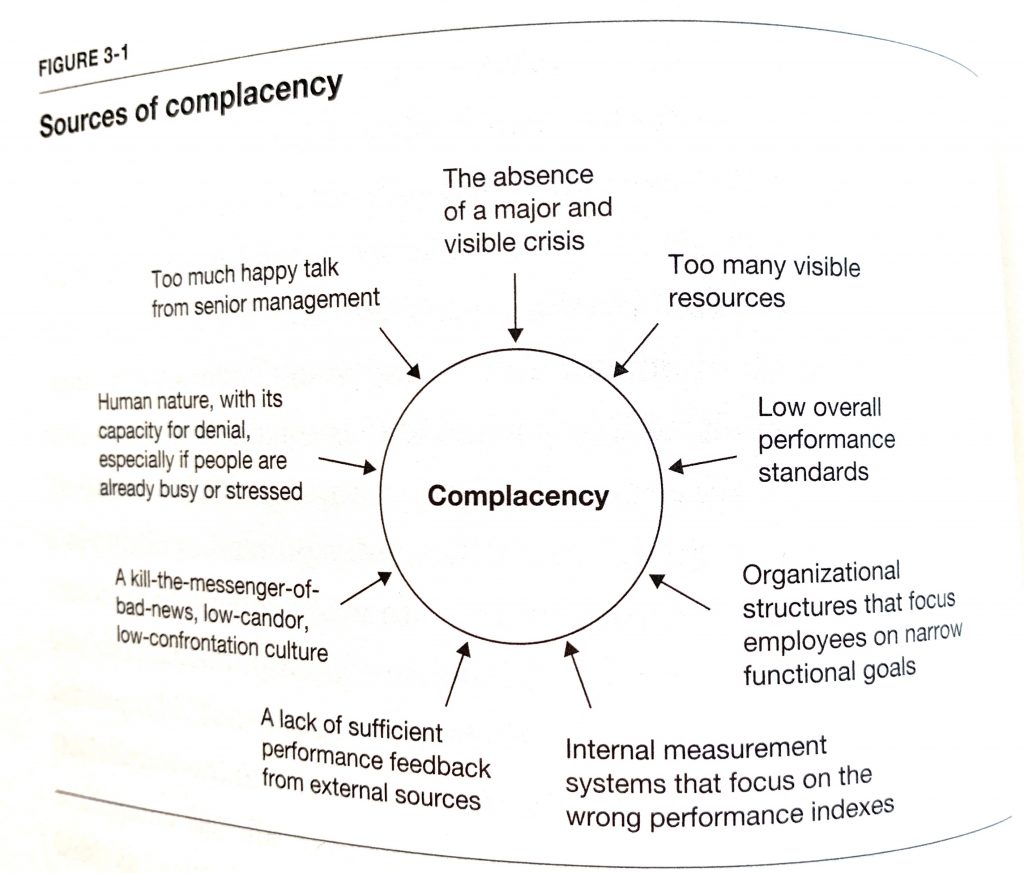I am constantly reminded how hard change is within an organization. I have encountered dozens of examples where and idea and outcome is crystal clear to me. But getting everyone to buy-in, implement and make the behavior change is incredibly difficult?
Why is that?
There are numerous answers to this question. I decided I wanted to increase my knowledge about change management and started researching who the experts are on this topic.
Leading Change by John P. Kotter comes highly recommended from several credible business resources. My Dad, an expert in his own right says this is one of the top books he recommends all leaders read.
After reading it, I would agree that this book discusses fundamental leadership qualities and practical strategies to make an impact with change management in your organization.
Below you will find my notes and insights from this book.
The Eight-Stage Change Process
Kotter suggests there are 8 phases that an organization must go through to properly institute change. To be clear, these aren’t minor changes like which type of food to serve in the cafeteria. These are changes that are coming from globalization, market changes, technology changes, regulations, competition and more.
The 8 stages are…
- Establish a sense of urgency
- Create the guiding coalition
- Develop a vision and strategy
- Communicate the change vision
- Empower broad-based actions
- Generate short-term wins
- Consolidate gains and produce more change
- Anchor new approaches in the culture
“People under pressure to show results will often try to skip phases – sometimes quite a few – in a major change effort.”
Page 24
It is critical that all major changes go through all 8 steps. You will find yourself working within several stages at once, but you should never skip a step thinking it’s already covered.
Management vs Leadership
This is a critical concept to understand when it comes to change management. I think Kotter’s definition is very concise so I will quote it below.
“Management is a set of processes that can keep a complicated system of people and technology running smoothly. The most important aspects of management include planning, budgeting, organizing, staffing, controlling, and problem-solving. Leadership is a set of processes that creates organizations in the first place or adapts them to significantly changing circumstances. Leadership defines what the future should look like, aligns people with that vision, and inspires them to make it happen despite the obstacles.”
Page 28
Kotter goes on to explain that for every major change to happen in an organization you need the right blend of leaders and managers making it happen. One cannot do it without the other. We will talk more about this later.
Establishing A Sense Of Urgency
It’s human nature to avoid risk and maintain the status quo. Without implementing dramatic changes you will breed an organization that is complacent.
Complacency should be avoided at all costs because it makes adapting to market changes very difficult. So much so, that losing money to affect change and create a crisis is discussed in the book as a real way to increase urgency.
Without urgency organizational leadership can fall into the trap of maintenance rather than innovation. Goals and incentives can be placed upon small improvements which prevent major change.
Urgency > Complacency.
Sources of complacency

Here are some practical ways to increase the urgency
- Create a crisis by allowing a financial loss, exposing managers to major weaknesses vis-a-vis competitors, or allowing errors to blow up instead of being corrected at the last minute.
- Eliminate obvious examples of excess
- Set revenue, income, productivity, customer satisfaction, and cycle-time targets so high that they can’t be reached by conducting business as usual.
- Stop measuring subunit performance based only on narrow functional goals. Insist that more people be held accountable for broader measures of business performance.
- Send more data about customer satisfaction and financial performance to more employees, especially information that demonstrates weaknesses
- Insist that people talk regularly to unsatisfied customers, unhappy suppliers, and disgruntled shareholders
- Use consultants and other means to force more relevant data and honest discussion.
- Put more honest discussion of the firm’s problems in the company newspapers and senior management speeches. Stop management “happy talk”.
- Bombard people with information on future opportunities, on the wonderful rewards for capitalizing on those opportunities, and on the organization’s current inability to pursue those opportunities.
Creating The Guiding Coalition
A guiding coalition is necessary to affect change. It should be a mixture of managers and leaders. If it skews too heavily to one side (managers vs leaders) it won’t work.
The leader’s role in this guiding coalition is to bring credibility, vision casting, and decision making to remove roadblocks and ensure the right people in the company pay attention to the change.
It is the manager’s role to build the plans, implement the change, and talk about it with their teams.
The purpose of the guiding coalition is to create the vision for the change, constantly talk about the vision and be the catalyst for the change. By holding themselves to higher standards and creating urgency they will be the inertia to affect change.
Even with a guiding coalition, change fails. So what gives?
“To some degree, a conflict of interest is involved. Teams aren’t promoted, individuals are, and individuals need unambiguous track records to advance their careers. The argument “I was on a team…” doesn’t sell well in most places today.”
Page 58
A guiding coalition can lose momentum if they don’t get the highest levels of leaders on the same page and excited about the change.
The book talks about trust and teamwork being the two most important factors for a successful guiding coalition. In order to make an impact, no egos, snakes, or outside detractors can take away from the vision and mission of the guiding coalition.
“Trust helps enormously in creating a shared objective. one of the main reasons people are not committed to overall excellence is that they don’t really trust other departments, divisions, or even fellow executives. They fear, sometimes quite rationally, that if they obsessively focus their actions on improving customer satisfaction or reducing expenses, other departments won’t do their fair share and the personal costs will skyrocket. When trust is raised a common goal becomes much easier.”
Page 68
Kotter recommends offsite as a great way to foster and build trust and set the vision for a guiding coalition.
Building a coalition that can make change happen.
1. Find the right people
- With strong positions of power, broad expertise, and high credibility
- With leadership and management skills, especially the former
2. Create trust
- Through carefully planned off-site events
- With lots of talk and joint activities
3. Develop a common goal
- Sensible to the head
- Appealing to the heart
Developing A Vision & Strategy
Vision refers to a picture of the future with some implicit or explicit commentary on why people should strive to create that future.
In a change based vision it should serve 3 purposes.
- Clarify the general direction for change, by saying the corporate equivalent of “we need to go south in 3 years instead of where we are heading today”.
- It motivates people to take action in the right direction, even if the initial steps are personally painful
- It helps coordinate the actions of different people, even thousands and thousands of individuals, in a remarkably fast and efficient way.
“Developing a good vision is an exercise in both the head and the heart, it takes some time, it always involves a group of people, and it is tough to do well.”
pg. 82
Creating an effective vision
First draft: The process often starts with an initial statement from a single individual reflecting both his or her dreams and real marketplace needs
Role of the guiding coalition: The first draft is always modeled over time by the guiding coalition or an even larger group of people.
Importance of teamwork: The group process never works well without a minimum of effective team work.
Role of the head and the heart: Both analytical thinking and a lot of dreaming are essential.
The messiness of the process: Vision creation is usually a process of two steps forward and one back, a movement to the left and then to the right
Time fame: Vision is never created in a single meeting. The activity takes months, and sometimes years.
End product: The process results in a direction for the future that is desirable, feasible, focused, flexible and is conveyable in five minutes or less.
Communicating The Change Vision
Communicate early and often. Keep it simple and multichannel.
Key elements to effectively communicate the change vision
- Simplicity – all jargon and technobabble must be eliminated
- Metaphor, analogy, and example – a verbal picture is worth a thousand words
- Multiple forums – Big meetings and small, memos and newspapers, formal and informal interaction – all are effective for spreading the word
- Repetition – ideas sink in deeply only after they have been heard many times
- Leadership by example – Behavior from important people that is inconsistent with vision overwhelms other forms of communication.
- Explanation of seeming inconsistencies – Unaddressed inconsistencies undermine the credibility of all communication
- Give and take – Two-way communication is always more powerful than one-way communication
“The downside of two-way communication is that feedback may suggest that we are on the wrong course and that the vision needs to be reformulated. But in the long run, swallowing our pride and reworking the vision is far more productive than heading off in the wrong direction – or in a direction that others won’t follow.”
pg. 103
Empowering Employees For Broad-Based Action
Empowering employees is all about removing structures that undermine the vision.
“Whenever structural barriers are not removed in a timely way, the risk is that employees will become so frustrated that they will sour on the entire transformational effort.”
pg. 110
Here is how to empower your teams
- Communicate a sensible vision to employees: give them a shared sense of purpose.
- Make structures compatible with the vision: make sure actions aren’t blocked.
- Provide the training employees need: without the right skills and attitudes, people feel disempowered.
- Align information and personnel systems to the vision: unaligned systems will block needed action
- Confront supervisors who undercut needed change: nothing disempowers people thew ay a bad boss can.
Generating Short-Term Wins
A good short-term win has at least these three characteristics:
- It’s visible; large numbers of people can see for themselves whether the result is real or just hype.
- It’s unambiguous; there can be little argument over the call.
- It’s clearly related to the change effort
The role of short-term wins
- Provide evidence the sacrifice is worth it
- Reward change agents with a pat on the back
- Help fine-tune vision and strategies
- Undermine cynics and self-serving resisters
- Keep bosses on board
- Build momentum
“Systematically targeting objectives and budgeting for them, creating plans to achieve those objectives, organizing for implementation, and then controlling the process to keep it on track – this is the essence of management.”
pg. 133
Consolidating Gains And Produce More Change
What stage 7 looks like
More change, not less – the guiding coalition uses the credibility afforded by short term wins to tackle additional and bigger change projects
More help – additional people are brough in, promoted, and developed to help with all the changes.
Leadership from senior management – senior people focus on maintaining clarity of shared purpose for the overall effort and keeping urgency levels up.
Project management and leadership from below – lower ranks in the hierarchy both provide leadership for specific projects and manage those projects.
Reduction of unnecessary interdependencies – to make change easier in both the short and long term, managers identify unnecessary interdependencies and eliminate them.
Anchoring New Approaches In The Culture
Comes last, not first – most alterations in norms and shared values come at the end of a transformational process
Depends on the results – new approaches usually sink into a culture only after it’s very clear that they work and are superior to old methods.
Requires a lot of talk – without verbal instruction and support, people are often reluctant to admit the validity of new practices
May involve turnover – sometimes the only way to change a culture is to change key people
Makes decisions on succession crucial – if promotion processes are not changed to be compatible with the new practices, the old culture will reassert itself
Join The Newsletter
Get occasional emails from me when I publish new projects and articles.



